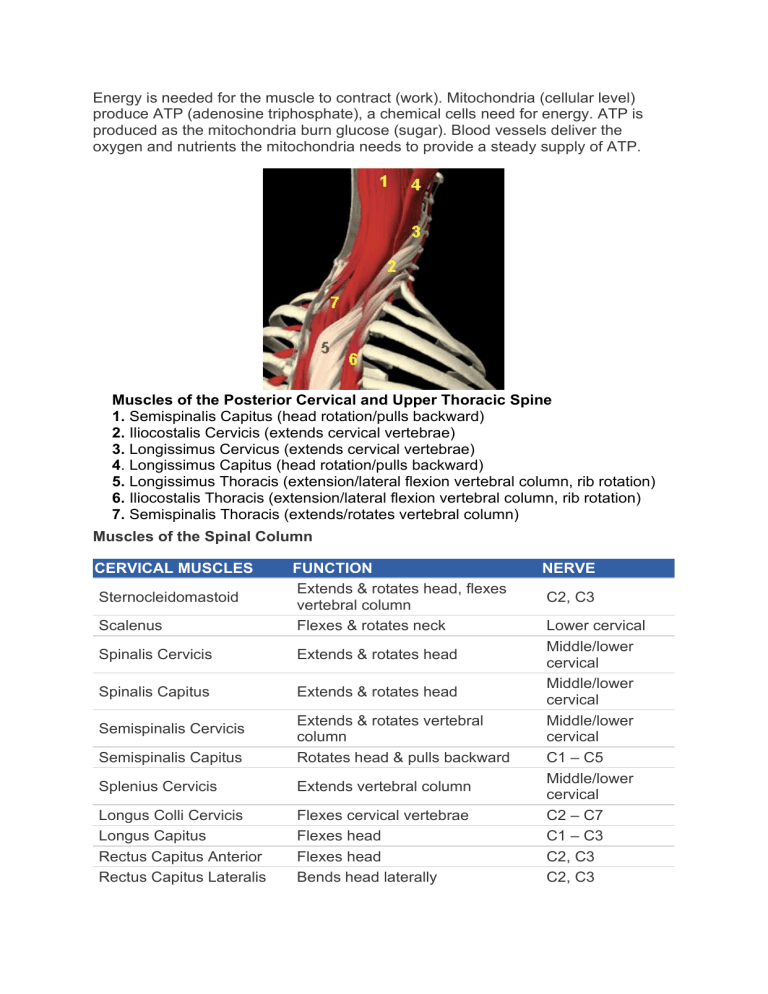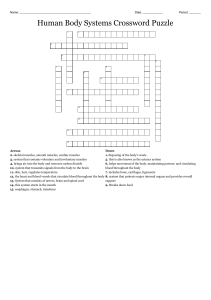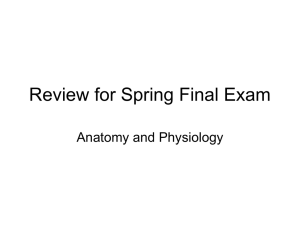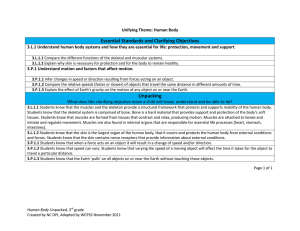
Energy is needed for the muscle to contract (work). Mitochondria (cellular level) produce ATP (adenosine triphosphate), a chemical cells need for energy. ATP is produced as the mitochondria burn glucose (sugar). Blood vessels deliver the oxygen and nutrients the mitochondria needs to provide a steady supply of ATP. Muscles of the Posterior Cervical and Upper Thoracic Spine 1. Semispinalis Capitus (head rotation/pulls backward) 2. Iliocostalis Cervicis (extends cervical vertebrae) 3. Longissimus Cervicus (extends cervical vertebrae) 4. Longissimus Capitus (head rotation/pulls backward) 5. Longissimus Thoracis (extension/lateral flexion vertebral column, rib rotation) 6. Iliocostalis Thoracis (extension/lateral flexion vertebral column, rib rotation) 7. Semispinalis Thoracis (extends/rotates vertebral column) Muscles of the Spinal Column CERVICAL MUSCLES Scalenus FUNCTION Extends & rotates head, flexes vertebral column Flexes & rotates neck Spinalis Cervicis Extends & rotates head Spinalis Capitus Extends & rotates head Sternocleidomastoid Semispinalis Capitus Extends & rotates vertebral column Rotates head & pulls backward Splenius Cervicis Extends vertebral column Longus Colli Cervicis Longus Capitus Rectus Capitus Anterior Rectus Capitus Lateralis Flexes cervical vertebrae Flexes head Flexes head Bends head laterally Semispinalis Cervicis NERVE C2, C3 Lower cervical Middle/lower cervical Middle/lower cervical Middle/lower cervical C1 – C5 Middle/lower cervical C2 – C7 C1 – C3 C2, C3 C2, C3 Iliocostalis Cervicis Extends cervical vertebrae Longissimus Cervicis Extends cervical vertebrae Longissimus Capitis Rotates head & pulls backward Rectus Capitus Posterior Major Rectus Capitus Posterior Minor Obliquus Capitus Inferior Obliquus Capitus Superior Middle/lower cervical Middle/lower cervical Middle/lower cervical Extends & rotates head Suboccipital Extends head Suboccipital Rotates atlas Extends & bends head laterally Suboccipital Suboccipital THORACIC MUSCLES FUNCTION Longissimus Thoracis Extension, lateral flexion of vertebral column, rib rotation Iliocostalis Thoracis Extension, lateral flexion of vertebral column, rib rotation Spinalis Thoracis Extends vertebral column Semispinalis Thoracis Extends & rotates vertebral column Rotatores Thoracis Extends & rotates vertebral column NERVE Dorsal primary divisions of spinal nerves Dorsal primary divisions of spinal nerves Dorsal primary divisions of spinal nerves Dorsal primary divisions of spinal nerves Dorsal primary divisions of spinal nerves LUMBAR MUSCLES FUNCTION NERVE Psoas Major Flexes thigh at hip joint & vertebral column L2, L3, sometimes L1 or L4 Intertransversarii Lateralis Lateral flexion of vertebral column Ventral primary division of spinal nerves Quadratus Lumborum Lateral flexion of vertebral column T12, L1 Interspinales Extends vertebral column Dorsal primary divisions of spinal nerves Dorsal primary divisions of spinal nerves Dorsal primary divisions of spinal nerves Dorsal primary divisions of spinal nerves Intertransversarii Mediales Lateral flexion of vertebral column Multifidus Extends & rotates vertebral column Longissimus Lumborum Extends & rotates vertebral column Iliocostalis Lumborum Extension, lateral Dorsal primary flexion of vertebral divisions of column, rib rotation spinal nerves Muscle Fascia Fascia is thickened connective tissue that envelops a muscle or a group of muscles. Superficial fascia is found directly under the skin. Epimysium is the fascia closest to the muscle. Perimysium divides the muscle into facicles – muscle fibers. Endomysium is another type of connective tissue that covers each muscle fiber. The back has a total of 40 muscles. There are 20 muscle pairs, one on each side of the body. Depending on how the muscles are counted, the total number may vary. The Muscles that Move the Head There are four sets of muscles that help move the head. These include: Sternocleidomastoids These are strong, large muscles are located on either side of the neck. Individually, they rotate the head left or right. Together, they flex or bend the head towards the chest. A person who complains of a stiff neck may have a problem with one of their sternocleidomastoids. The semispinalis capitis, splenius capitis, and longissimus capitis muscles all help the head extend toward the back. They also work with sternocleidomastoid muscles to rotate the head left and right. After working on the computer with their head bent forward, a person might feel soreness in these muscles. Semispinalis Capitis Splenius Capitis Longissimus Capitis The Muscles that Move the Shoulders There are seven pairs of muscles that move the shoulders. Three of these pairs are chest muscles, not back muscles. The four back muscle pairs are: Trapezius These large muscles – sometimes called traps – are shaped like trapezoids or diamonds. They move the shoulder bones (also called scapulae). In addition, they help move the collar bones. Levator Scapulae These muscles raise the shoulder bones. “Levator” means raise. Rhomboideus Major and Minor Also called rhomboid major and rhomboid minor, these two pairs of muscles also help move the shoulder bones. The Muscles that Move the Upper Arms Five pairs of back muscles that help move the upper arms. These are: Latissimus Dorsi These large wing-shaped muscles extend from the upper to the lower back. Sometimes known as the lats, they help move the arms and shoulders. Supraspinatus and Infraspinatus Together with the deltoid muscles, the supraspinatus muscles move the upper arms. The infraspinatus muscles help rotate or turn the arms. Teres Major and Minor These muscles help move the arms in many ways. For instance, the teres minor muscles aid in rotating or turning the arms. The Muscles that Move the Spine There are several sets of muscles that help move the spine. In the back, these muscles include: Sacrospinalis There are three groups of muscles that make up the sacrospinalis. These extend from the neck area to the lower back. Spinalis and Iliocostalis The spinalis are muscles that are closest to the spine. There is a set of muscles in the upper back (called the thoracic area) called the spinalis thoracis. The iliocostalis muscles are furthest from the spine. There are three sets of iliocostalis muscles: 1) in the cervical area (iliocostalis cervicis), 2) in the upper back or thoracic area (iliocostalis thoracis), and 3) in the lumbar area (iliocostalis lumborum). Longissimus and Quadratus Lumborum The longissimus (red, in the image above) are located between spinalis and the iliocostalis muscles. There are three sets of longissimus muscles: 1) above the cervical area (longissimus capitis), 2) in the cervical area (longissimus cervicis), and 3) in the upper back or thoracic area (longissimus thoracis). The quadratus lumborum muscles (orange, in the image above) are found in the lower back (also called the lumbar area). They help to bend the back to one side or the other. The Muscles that Move the Upper Legs (Thigh) There are many muscles that move the large bone of the thigh. These include: Iliopsoas The psoas major and iliacus muscles make up the iliopsoas. These go from the lumbar spine to each of the thigh bones (also called femurs). In addition to moving the thigh, these muscles help bend the back. Psoas Minor A smaller muscle, called the psoas minor, is located in front of the iliopsoas.



